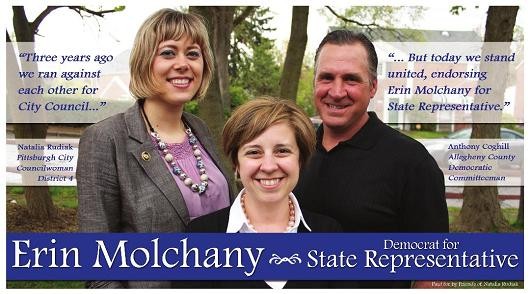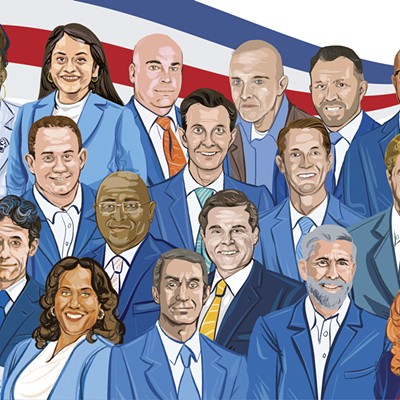Wednesday, April 18, 2012
Lines Drawn in District 22 state Rep race
File this under "politics makes strange bedfellows": It's the front of a flyer being sent out by the campaign of state Rep. candidate Erin Molchany in District 22:
The folks you see there are Molchany with two of her supporters: City Councilor Natalia Rudiak and a former rival, Tony Coghill. In fact, Coghill and Molchany herself have previously been on opposite sides of thie own election battle: Back in 2010, Molchany lost her seat on the Democratic Committee to Lisa Orlando, Coghill's one-time campaign manager, during Coghill's failed effort to topple Pete Wagner as chair of the party's 19th Ward Committee. (ADDED: I should also say that while the Coghill/Wagner battle was personal, as we'll see, Coghill only had kind things to say about Molchany even back in 2010. Orlando and Molchany just happened to live in the same neighborhood.)
So why are these folks all on the same side now?
Part of what's going on here is obvious: As I hinted in a brief write-up of this race, Coghill is looking to even the score with Wagner, a former ally, by helping Molchany beat the candidate Wagner is backing in this race, Marty Schmotzer. Watchers of this space know that part of the reason Rudiak beat Coghill in the first place back in 2009 was a split between Coghill and the Ward 19 chair. Coghill's attempt to oust Wagner from the committee in 2010 stemmed from that loss, and the bad feelings obviously continue. Schmotzer and Coghill have both told me that they exchanged words at a recent fundraiser for Congressman Mike Doyle at LeMont. The confrontation got so heated that a rumor spread that someone had nearly taken a swing at Mayor Luke Ravenstahl ... who just happened to be standing nearby.
Rudiak and Molchany's alliance is even easier to understand. Both are progressive women who draw from a similar base of support. And Rudiak is up for re-election next year: Having an ally in the state House sure wouldn't hurt, especially if Rudiak ends up facing another Wagner-backed rival.
If I had to bet on this race, I'd still pick Schmotzer: He's the endorsed Democrat in a special election taking place on the same ballot, and Pete Wagner has been pushing him hard. That's a tough combination to beat. But if Molchany did pull this off, it would be a sign that the political geography is shifting under Wagner's feet ... and in a legislative seat previously held by his own daughter, Chelsa.
Actually, we may as well note the landscape may be shifting anyway.
As you probably have heard, we're in the midst of a protracted battle over redrawing the lines of state legislative districts. And there's been some kvetching about how the GOP-led legislative redistricting runs roughshod over the North Hills, divvying up communities between districts to serve political ends. What's gotten less attention is how redistricting could affect Wagner's own political fiefdom.
The 19th is a sprawling district; while centered on Beechview, it also encompasses portions of Brookline and Mt. Washington. Previously, it has been contained solely within the 22nd legislative district, where it was joined by the outlying suburbs of Baldwin, Whitehall and Castle Shannon. But the redistricting plan carves the 19th into three separate legislative districts. One chunk of the 19th will end up in the 27th district, where it will be lumped in with the city's western neighborhoods and the adjoining suburbs of Green Tree, Crafton, Ingram, McKees Rocks and Thornburg. Another chunk will be fused with portions of the city's South Side, Mt. Oliver, Brentwood and portion of Baldwin. The third part of the 19th will be merged into district 42, joining Dormont, Castle Shannon, and parts of Baldwin and Mt. Lebanon.
Now there's an obvious question here: How much sense does it make to split up Beechview and Brookline, and pair them up with suburbs? What possible rationale could explain divvying up two working-class city neighborhoods that way?
One suspicion, popular in some South Hills circles, is that these lines were drawn precisely to dilute Wagner's influence, by spreading it across three separate districts. It's no accident that when I interviewed Schmotzer himself a few weeks ago, he said that if elected, he'd do everything he could to preserve the district -- and the integrity of political wards and boundaries.
I don't know how much Wagner really has to worry about. As he once memorably told me after fending off Coghill's committee insurgency, "Rumors of my demise have been greatly exaggerated." (In full disclosure, it was pretty clear Wagner thought I was the one exaggerating them.) A look at election results in the 2010 primary also suggests Wagner may be able to retain most if not all of his influence, even if he has to shift his weight a bit.
In 2010, Chelsa Wagner was running unopposed in the 22nd. And of the 7600-plus votes cast in her race, roughly 53 percent were cast in the 19th ward. To gauge how much strength the ward would have under the proposed boundaries, I looked at legislative races in the districts the 19th would be split among. The results weren't as bad as you might think.
In House district 36, the ward 19 vote would have been swamped just by the votes cast in Brentwood and Baldwin. And in District 42? Forget it: The portion of Ward 19 in that district wouldn't have enough votes to keep pace with Dormont, never mind a huge community like Mt. Lebanon. But in district 27 -- where most of the ward's precincts would be transferred -- the 19th ward would still have accounted for a narrow majority of votes, about 50.7 percent.
So it'd be stupid to say this race is Pete Wagner's last hurrah; I've learned not to count the guy out. But a base to rival his own may be starting to take shape ... at the very moment he may have to start reaching out to new constituencies.










